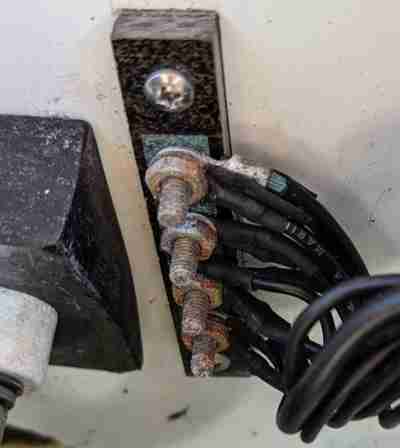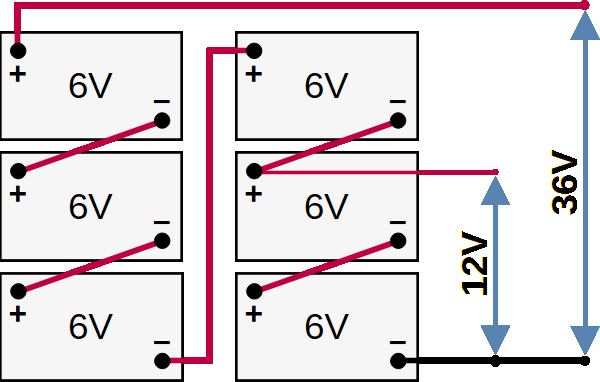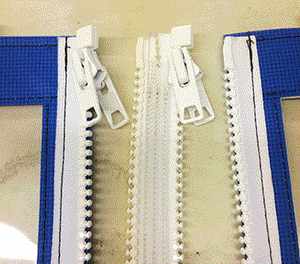Known Issues and Fixes
Electrical Issues
Circuit Protection
The general rule is to protect the wire, then protect down stream devices. The idea is that
if a short were to occur in the wire, up-stream circuit protection would trip before the
wire becomes dangerously hot or melts. A second level of circuit protection would be used at
or near each device to protect the device.
This web site
 provides a much more detailed description.
provides a much more detailed description.
Blue Sea is also a good source of technical information.

-
Problems with the Duffy include:
- No circuit protection at or near connections to the batteries.
-
Incorrect circuit protection devices. Check protection device ratings and the loads they
protect.
All circuit breakers on our instrument panel are 10A and usually have no additional circuit protection after the breaker, though the loads are all 3A or less. Note that a single circuit may branch to feed other devices.
In-line fuses should also be checked.
Marine-Grade Wiring is Not Always Used
Marine-grade wiring is made with tinned copper to avoid corrosion. The insulation is also much tougher.
Ground Bus Corrosion
A low quality unprotected ground bus is located in the motor compartment and is likely to
corrode. Since these circuits are shared, you may experience odd behaviors in your
electrical systems as devices try to find a way to ground.
Note in the picture that one of the ground wires has visible green corrosion and some of the
insulation has come off. This is not marine-grade wire.

Solution: Replace with a high quality bus and replace wire terminals that are corroded.
Unclear Circuit Paths
There is no central fuse or circuit breaker panel. The circuit breakers on the console are the closest thing, but they supply power to more devices than the labels indicate and the amperage is incorrect.
Improperly Shielded High Voltage Line
The original battery charger has a 120VAC circuit running to the Charger On light on the console. The wiring is minimally shielded and is indistinguishable from the 12V wiring that surrounds it.
Cabin Heater
The issues with the cabin heater are described here.
Battery
Unequal Loading Across Battery Bank
To get the most life out of your battery bank, all batteries should charge and discharge equally so that they wear at the same rate. The more batteries you have connected, the harder this is to achieve due to varying resistance between the batteries and the charger and/or loads. More connections equal more built-up resistance. If one or more batteries in the bank are worked harder, they will fail sooner. Replacing only those batteries would create a new imbalance, which is why all batteries are replaced as a set with the same type and size of battery.
Battery balancers are able to equalize small differences between batteries to maximize their life. They compare battery voltages and draw current from one battery to increase the charge of another until an equal state of charge is achieved across all batteries.
On the Duffy, 12V is provided by tapping two 6V batteries in series out of the 36V or 48V battery bank. This draws more power from these batteries and causes them to wear out more quickly than the other batteries.

The imbalance is more than a battery balancer could compensate for, so the best alternative is to use a DC-DC converter to provide 12V from your 36V/48V battery bank to feed all of your 12V systems.
Ineffective Battery Monitoring
The Duffy Energy Meter on the console appears to be indicating battery State of Charge, with Full and Empty markings at each end. In reality, it is just a volt meter that is not very helpful in determining state of charge. See the Battery Monitoring section for more information.
Charging
Charge Cycle
When your battery charger is plugged-in to shore power, it checks battery voltage to determine if a charge is needed, then begins a charging cycle if necessary. Most battery charges will not check again until shore power is disconnected and reconnected. This is fine for most people, but if you leave your boat for long periods, you should find a charger that can top-off the batteries periodically.
Trojan T-105 batteries self discharge at a rate of 5–15% per month, depending on the temperature.
Navigation lights
This is not Duffy-specific, but the plastic lenses on navigation lights become cloudy over time and need replacement. More information can be found in the navigation lighting section.
Windows
The original Duffy windows were made from a soft plastic that deforms and scratches easily, limiting visibility. Much more durable window materials are available and should be considered when replacement is required.
It is common for the clear plastic windows and canvas to shrink over time. This strains the
zippers and can make it difficult to open/close them. A simple fix is to add a
zipper extension
 . These come in different colors, lengths and tooth
patterns to match your existing canvas.
. These come in different colors, lengths and tooth
patterns to match your existing canvas.

